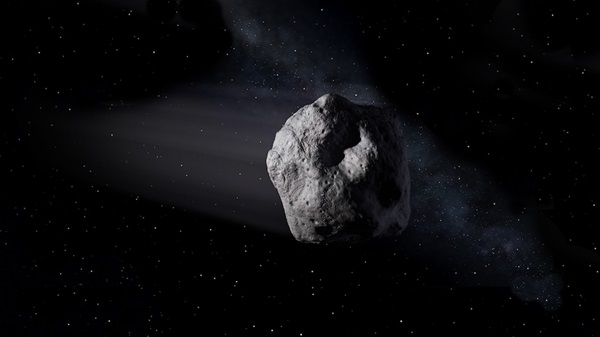Atira asteroids: Space rocks that orbit near the Sun – Astronomy Magazine
Atira asteroids, like the newly discovered asteroid 2019 LF6, are a unique class of near-Earth objects (called interior-Earth objects) with orbits that are entirely contained within Earth’s orbit. This artist’s concept depicts a near-Earth asteroid hurtling through space.
NASA/JPL-Caltech
Astronomers just found an asteroid circling surprisingly close to our home Sun, adding one more sibling to a rare family of space rocks.
Our solar system has a lot of rubble left over from its creation that’s strewn haphazardly between and beyond the planets. But there is some order to the mess. At the outer extremes, the Oort Cloud encloses the solar system in a giant sphere made of comets that occasionally swing in for a solar visit. The Kuiper Belt, orbiting beyond Neptune, is a ring of bodies from pebble up to Pluto-sized objects of rock and ice. And the Asteroid Belt, between Mars and Jupiter, hosts a range of rocky bodies.
Over the years, astronomers have logged the largest of these bodies, to make sure none are on collision paths with Earth. And they’ve done a good job, at least with the asteroids most likely to take a turn through Earth’s territory, called near-Earth objects (NEOs). But every now and then, a surprise sneaks in.
Quanzhi Ye, an astronomer at the California Institute of Technology, recently found an asteroid half a mile across called 2019 LF6. It’s one of a small family of Atira asteroids, whose orbits never stray farther from the Sun than Earth’s orbit. He spotted it using the Zwicky Transient Facility, a telescope that scans wide swaths of the skies for targets that appear and disappear on short time frames – such as exploding stars and quick-moving. He and his colleagues published their finding to the International Astronomical Union’s Minor Planet Center, which catalogs such bodies, on June 19.
Big and fast
Astronomers were surprised to find 2019 LF6 for two reasons. For one, astronomers thought they knew about most of the asteroids half a mile across or larger. Since 1998, NASA’s NEO survey has been trying to catalog asteroids a kilometer (roughly half a mile) or larger. And they believe they’ve discovered over 90 percent of these large bodies. So finding a new one in the inner solar system, relatively close to home, is somewhat of a surprise.






